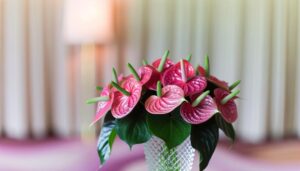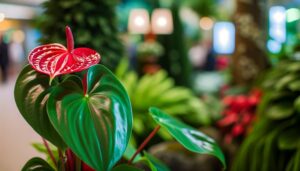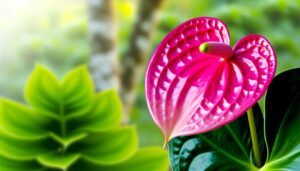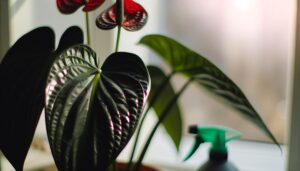What Makes the Anthurium Hawaiian Volcano Plant Unique?
The Anthurium Hawaiian Volcano plant is unique for its ability to thrive in volcanic rock substrates, offering excellent aeration and nutrient-rich support. This plant features heart-shaped, glossy leaves and vibrant inflorescences with deep red to bright pink spathes and spadices.
Its specialized root system enhances nutrient absorption and water uptake, enabling survival in diverse environments. Beyond its aesthetic appeal, the plant contributes significantly to soil stability, fertility, and local biodiversity.
Ideal care involves maintaining high humidity, bright indirect light, and consistent moisture. For those seeking further insights into its cultivation and ecological impact, much more knowledge awaits.
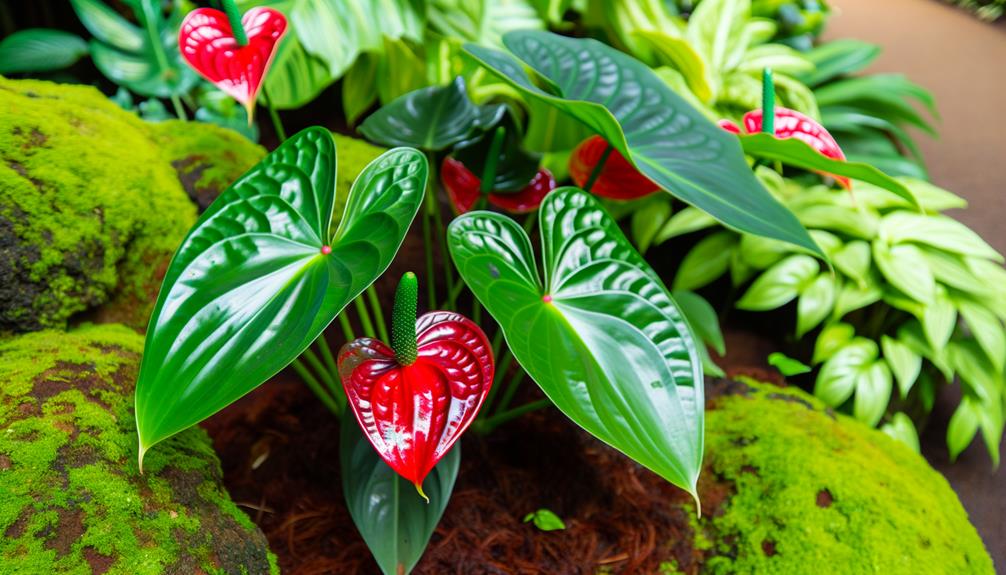
Key Takeaways
- Grows in nutrient-rich volcanic rock substrate that enhances root oxygenation and prevents diseases.
- Features heart-shaped, glossy, dark green leaves with vibrant inflorescences in deep red to bright pink colors.
- Specialized root system excels in nutrient absorption and water uptake, thriving in nutrient-deficient environments.
- Contributes to local biodiversity by providing habitat for invertebrates and attracting pollinators.
- Plays a vital ecological role in soil stabilization and enhancing soil fertility in volcanic habitats.
Origins and History
The Anthurium Hawaiian Volcano Plant, a cultivar derived from the tropical Anthurium genus, traces its origins to the biodiverse rainforests of Central and South America, where it thrives in the nutrient-rich volcanic soils. This species is part of the Araceae family, known for its extensive variety and adaptability to diverse ecological niches.
The volcanic substrates provide essential minerals, fostering robust growth and vibrant foliage. Over centuries, indigenous cultures utilized Anthurium for ornamental and medicinal purposes. The unique horticultural practice of cultivating Anthurium on lava rocks in Hawaii has further refined and popularized this plant.
This practice enhances the plant's resilience and aesthetic appeal, making it a sought-after variety in modern horticulture for both indoor and outdoor decoration.
Distinctive Appearance
Distinguished by its glossy, heart-shaped leaves and vibrant inflorescences, Anthurium Hawaiian Volcano Plant exhibits a remarkable appearance that captivates both botanists and horticultural enthusiasts.
The leaves, typically dark green and highly reflective, can reach up to 30 centimeters in length, contributing to its lush, tropical aesthetic.
The inflorescences, composed of a spathe and spadix, are strikingly vibrant, ranging from deep reds to bright pinks. The spathe's waxy texture and bold coloration provide a dramatic contrast to the plant's foliage.
Additionally, the spadix, a cylindrical structure, is covered with minute flowers that add to the plant's exotic allure. This combination of vivid colors and unique textures makes the Anthurium Hawaiian Volcano Plant a standout in any botanical collection.
Unique Growing Medium
The Anthurium Hawaiian Volcano Plant thrives in a growing medium comprising volcanic rock substrate, which offers unmatched aeration and support.
This medium, rich in nutrient-laden lava soil, provides essential minerals that enhance plant vigor. Additionally, its excellent drainage properties prevent waterlogging, promoting ideal root health.
Volcanic Rock Substrate
Volcanic rock substrate, characterized by its excellent flow and aeration properties, provides an ideal growing medium for Anthurium Hawaiian Volcano plants. This substrate facilitates prime root oxygenation, preventing waterlogged conditions that can lead to root rot. The porous nature of volcanic rock guarantees efficient water retention while allowing excess moisture to drain away, creating a balanced environment for root health.
| Property | Impact on Plant Growth |
|---|---|
| Flow | Prevents waterlogging, reducing the risk of root diseases |
| Aeration | Enhances root oxygenation, promoting vigorous root development |
| Porosity | Balanced moisture retention, supporting consistent hydration |
Volcanic rock's mineral composition also provides a stable anchoring system for the roots, fostering robust plant development. This unique medium is fundamental to the thriving of Anthurium Hawaiian Volcano plants, securing sustained growth and energy.
Nutrient-Rich Lava Soil
Building on the benefits of volcanic rock substrate, nutrient-rich lava soil further enhances the growth environment for Anthurium Hawaiian Volcano plants by providing a unique blend of minerals and trace elements essential for ideal plant health.
This specialized medium is rich in iron, magnesium, calcium, and other micronutrients that are progressively released as the soil weathers. The porous nature of lava soil also facilitates optimum root aeration, promoting robust root development and efficient nutrient uptake.
Additionally, the presence of silicate minerals contributes to the plant's structural integrity, enhancing its resilience against environmental stressors. The slow release of these essential nutrients ensures sustained availability, fostering a balanced and thriving plant ecosystem that supports vigorous growth and vibrant foliage.
Excellent Drainage Properties
Harnessing the distinct qualities of lava soil, Anthurium Hawaiian Volcano plants benefit from exceptional drainage capabilities that prevent waterlogging and root rot. The porous nature of volcanic rock creates an ideal growing medium by allowing excess water to swiftly percolate through the soil matrix. This trait ensures that the roots remain aerated, reducing the risks associated with stagnant water, such as fungal infections and anaerobic conditions.
Additionally, the lava soil's high cation exchange capacity facilitates the retention and gradual release of essential nutrients, promoting sustained plant health. The unique combination of these properties makes the lava soil a perfect substrate for cultivating Anthurium Hawaiian Volcano plants, enhancing their resilience and overall growth performance.
Resilience and Adaptability
The Anthurium Hawaiian Volcano plant exhibits remarkable resilience and adaptability, thriving in the challenging and nutrient-deficient environments often found on volcanic substrates. This species demonstrates an extraordinary ability to endure high levels of mineral content and low organic matter, owing to its specialized root systems and efficient water uptake mechanisms. Additionally, it can withstand temperature fluctuations and varying humidity levels, making it an excellent candidate for cultivation in diverse climatic conditions.
| Characteristic | Description | Significance |
|---|---|---|
| Root System | Specialized and extensive | Enhances nutrient absorption |
| Water Uptake | Highly efficient | Maintains hydration in dry soils |
| Temperature Tolerance | Broad range adaptability | Survives in fluctuating climates |
These traits collectively underscore the plant's robust nature and its capacity to flourish in less-than-ideal conditions.
Ecological Significance
The Anthurium Hawaiian Volcano Plant thrives in the unique volcanic soils of Hawaii. It plays an essential role in its native growth habitat by stabilizing soil and preventing erosion. Its environmental benefits include enhancing soil fertility and contributing to carbon sequestration.
Additionally, the plant supports local biodiversity by providing habitat and resources for various endemic species.
Native Growth Habitat
Anthurium Hawaiian Volcano plants flourish in the distinct volcanic soil and moist microclimates of Hawaii's tropical rainforests, significantly contributing to local biodiversity. Characterized by a complex symbiosis with native flora and fauna, these plants demonstrate remarkable adaptability to nutrient-rich, porous volcanic substrates and consistent moisture levels. The specific conditions of their native habitat support ideal growth and a strong root system.
| Factor | Description |
|---|---|
| Soil Composition | Abundant in minerals, well-draining volcanic soil |
| Humidity Levels | High, steady humidity |
| Temperature Range | Warm, consistent temperatures typical of tropical zones |
| Native Flora Interaction | Mutualistic relationships enhancing ecosystem health |
| Moisture Availability | Dependable due to frequent rainfall and high humidity |
This unique habitat promotes the Anthurium Hawaiian Volcano plant's ecological success, nurturing its unique characteristics.
Environmental Benefits
Given their robust adaptability and symbiotic relationships within Hawaii's tropical rainforests, these plants play a pivotal role in enhancing soil fertility, stabilizing ecosystems, and supporting diverse biological communities.
The Anthurium Hawaiian Volcano plant contributes to nutrient cycling by decomposing organic matter, thereby enriching the soil with essential minerals. Its extensive root systems help prevent soil erosion by anchoring the substrate, thereby maintaining soil structure and integrity.
Additionally, the plant's presence fosters a microhabitat conducive to various microorganisms and invertebrates, which further facilitate nutrient breakdown and soil health. Its ability to thrive in volcanic substrates also aids in the colonization of barren landscapes, leading to the gradual development of more complex ecological networks.
Biodiversity Contribution
Thriving in Hawaii's unique volcanic landscapes, Anthurium Hawaiian Volcano plants greatly enhance local biodiversity by providing habitat and resources for a myriad of species. Their broad, glossy leaves create microhabitats for various invertebrates, while their vibrant inflorescences attract pollinators such as bees, butterflies, and hummingbirds.
The plant's root systems contribute to soil stabilization, promoting the growth of other endemic flora. Additionally, the presence of Anthurium enhances nutrient cycling and organic matter deposition, fostering a richer, more resilient ecosystem.
This ecological role underscores the plant's significance in maintaining the intricate balance of Hawaii's volcanic habitats, making it an invaluable component of the region's biodiversity and ecological health.
Care Requirements
Proper care for the Hawaiian Volcano Plant involves maintaining specific humidity levels, ideal light exposure, and precise watering routines. Best humidity levels for this plant range between 60-80%, requiring regular misting or the use of a humidifier.
Light exposure should be indirect but bright, as direct sunlight can scorch the leaves, while insufficient light can hinder growth. Watering routines must be carefully managed; the substrate should remain evenly moist but not waterlogged. A well-draining potting mix, enriched with organic matter, is crucial to prevent root rot.
Additionally, maintaining temperatures between 65-75°F (18-24°C) ensures strong growth. Fertilization, with a balanced, diluted solution, should occur monthly during the growing season to support its nutritional needs.
Common Varieties
Understanding the care requirements sets a solid foundation for appreciating the diverse common varieties of the Anthurium Hawaiian Volcano Plant, each exhibiting unique morphological and physiological traits.
Among the notable varieties is Anthurium andraeanum, characterized by its glossy, heart-shaped spathes and vibrant spadices. Anthurium scherzerianum is distinguished by its coiled spadix and more compact growth habit. Another significant variety, Anthurium clarinervium, features prominently veined, velvety leaves that contrast sharply with its relatives.
Each variety requires specific microenvironmental conditions, including humidity levels and substrate composition, to optimize growth. These distinctions not only underscore the plant's adaptability but also its aesthetic versatility, making it a prized addition to both botanical collections and interior landscapes.
Propagation Techniques
Propagation of the Anthurium Hawaiian Volcano Plant can be effectively achieved through several techniques. Seed germination requires a warm, humid environment with temperatures maintained between 70-85°F, and a well-draining, sterile medium. Stem cuttings involve selecting healthy, disease-free stems, treated with rooting hormone, and placed in a moist, sterile substrate. Division of mature clumps requires careful separation of root masses, ensuring each new division has adequate roots and shoots.
Each method requires precise environmental controls and handling methods to ensure successful establishment and growth. Maintaining ideal humidity, temperature, and light conditions is crucial in all methods to promote robust root development and plant well-being.
Common Challenges and Solutions
Encountering issues such as root rot, pest infestations, and nutrient deficiencies can impede the growth and health of the Anthurium Hawaiian Volcano Plant, necessitating precise intervention strategies to mitigate these challenges.
Root rot, often caused by overwatering, can be mitigated by ensuring well-draining soil and appropriate watering schedules.
Pest infestations, including aphids and spider mites, can be managed through the application of insecticidal soap or neem oil.
Nutrient deficiencies, indicated by yellowing leaves or stunted growth, may be rectified by administering a balanced, water-soluble fertilizer containing essential micronutrients.
Regular monitoring and early detection are crucial to maintaining plant strength, with adjustments to environmental conditions such as light, humidity, and temperature playing critical roles in mitigating these common challenges.
Conclusion
The Anthurium Hawaiian Volcano plant, with its distinctive appearance, unique growing medium, and remarkable resilience, stands as an exemplar of botanical marvels.
Ironically, its ecological significance and adaptability highlight nature's intricate balance, juxtaposed with the oft-neglected complexities of its care requirements and propagation challenges.
The plant's allure is not merely in its aesthetic appeal but in the precise horticultural expertise it demands, underscoring the fine line between botanical admiration and the arduous endeavor of cultivation.

